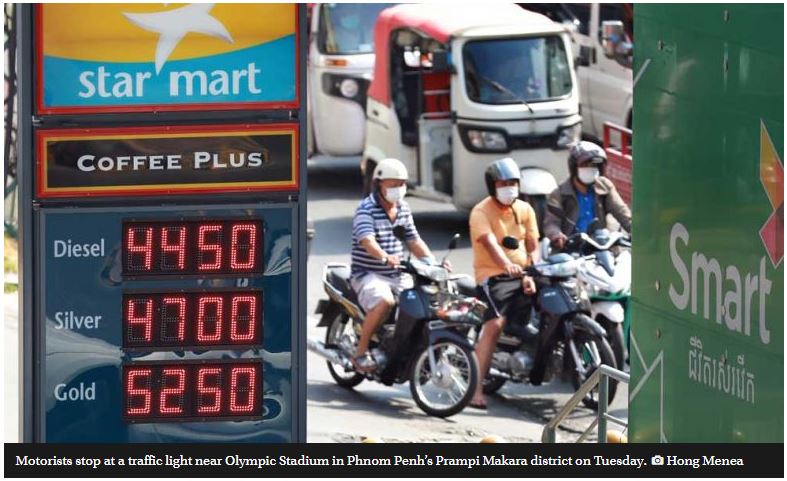Cambodia: Retail fuel rates raised for fifth time
Economists and manufacturing players are concerned about the relentless rise in Cambodian fuel prices, which they blame for a general upswing in the prices of other goods and services – a trend many fear may be extended by Russia’s military offensive in Ukraine.
The retail selling prices of fuel in the Kingdom from March 1-15 have been set at 4,800 riel or $1.18 per litre of regular EA92 – petrol with an octane rating of at least 92 – and 4,500 riel or $1.11 per litre of diesel, the Ministry of Commerce said in a notice that contains values in both currencies.
This is the fifth bimonthly period in a row that these prices have been hiked. The corresponding rates for February 16-28 were 4,700 riel ($1.16) and 4,450 riel ($1.09) per litre of regular EA92 and diesel, respectively, up from 4,100 riel ($1.00) and 3,750 riel ($0.92) in December 16-31 – the most recent trough.
Compulsory for licensed filling stations – although usually not strictly enforced for street vendors, the pricing serves as a tool to facilitate and enhance cost control nationwide and is calculated semi-monthly by the ministry, using data extrapolated from fluctuations in crude prices on the international market and feedback from meetings with local oil importers and other relevant parties.
International crude prices have been on a rally in the last few days, on the back of concerns over Russian President Vladimir Putin’s order for top military officials to put their nuclear forces into “special combat readiness”, as fighting intensified across Ukraine.
Brent futures were up $3.25, or 3.32 per cent, to $101.22 a barrel at 1026 GMT on March 1, while US West Texas Intermediate (WTI) crude had gained $2.70, or 2.82 per cent, reaching $98.42, according to Investing.com.
Both Brent and WTI reached their highest levels since 2014 on February 24, the day Russia began its military offensive on its neighbour Ukraine, respectively at $105.79 and $100.54 a barrel, data from the financial markets platform indicate.
Hong Vanak, director of International Economics at the Royal Academy of Cambodia, affirmed that the sharp rise in fuel prices was a global phenomenon, which he said had been especially evident from mid-2021 after the Covid-19 pandemic loosened its grip on the world, and manufacturing units were allowed to resume work.
But Russia’s countrywide attack on Ukraine is sending international oil prices higher – a trend that is most likely to continue, he told The Post.
“If the Russia-Ukraine crisis persists and the Organisation of the Petroleum Exporting Countries [OPEC] still refuses to increase its production, oil prices will not easily fall,” he said.
On the contrary, Vanak contended that the conflict could provide some oil producers a chance to hike up their prices under the pretext of insufficient supply.
Either way, he said, an end to the ongoing Russia-Ukraine crisis would not likely drive oil prices down very far, and pressure on oil-importing countries such as Cambodia would persist, increasing production costs across the spectrum of industries.
Keo Mom, CEO of Ly Ly Food Industry Co Ltd, one of the Kingdom’s largest food processing businesses, voiced frustration that the rising fuel prices had driven up costs for shipping and raw materials.
And at the same time, she said, sales have slipped into a downward slope, and thus the increased costs were chipping away at profit margins and forcing cuts in production capacity to “virtually nothing”.
“Sustained jumps in fuel prices would – as a matter of fact – not only affect local industry, but everyone’s livelihoods. There is a huge demand today for fuel for vehicles, and the manufacturing sector is among the most affected,” she said.
On the flip side, Cambodia Rice Federation secretary-general Lun Yeng reported that detrimental knock-on effects on the rice sector from the spiralling fuel prices were minimal, and would likely remain so in light of the situation in Ukraine.
But the sector is not without its challenges, the main issues of which Yeng said concern long-distance transportation and the ongoing global shortages of shipping containers.
A global reduction in the production of raw materials for agricultural fertilisers, coupled with soaring shipping costs, has led to higher prices around the world for the nutritional supplements – a pattern not exclusive to Cambodia, he said.
He noted that some raw material producers had cut down on production over global warming concerns, and that a fair share of petroleum-based fertilisers are derived from crude oil sourced from Russia.
The ministry notice shows that the current semi-monthly regular EA92 rate was calculated by adding the $0.6919 average Means of Platts Singapore (MOPS) over February 16-28, $0.1847 in taxes and associated charges ($0.0635 in customs duty, $0.0200 in additional fees and $0.1013 in special fees) and $0.20 premium – summing up to about $1.077 – plus an extra 10 per cent surcharge on top of that for a total of $1.1843 or 4,814 riel, which were then adjusted to their final values.
Similarly, the diesel rate was computed from a $0.7050 mean MOPS (over the same nine working days), $0.0742 in taxes and associated charges ($0.0000 in customs duty, $0.0400 in additional fees and $0.0342 in special fees) and $0.23 premium – tallying up to around $1.009 – with a 10 per cent fuel surcharge for a sum of $1.1101 or 4,513 riel, which were then rounded to their current values.
And as has been customary since 2018, the notice mentioned that the two current per-litre rates include a $0.04 reduction approved by Prime Minister Hun Sen “to ease the people’s livelihoods”.
Source: https://www.phnompenhpost.com/business/retail-fuel-rates-raised-fifth-time


 Thailand
Thailand




